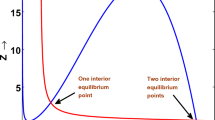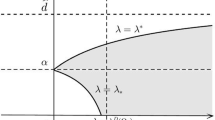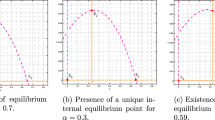Abstract
This article considers a reaction–diffusion predator–prey model with schooling behavior both in predator and prey species and subject to the homogeneous Neumann boundary condition on a square domain. With the help of the standard linearized analysis, the spatially homogeneous Hopf bifurcation curve and the Turing bifurcation curve of the unique constant positive steady state are obtained. These curves divide the existence domain of the constant positive steady state of the model into the stable, the Hopf unstable, the Turing unstable and the Hopf–Turing unstable regions. When the parameters are in the Turing unstable domain and near the Turing bifurcation curve, by applying the multiple-scale analysis and the successive approximations, the amplitude equations of the system near the constant steady state are derived. Meanwhile, the classification and stability of the patterns of the system are presented in terms of the existence and stability of the stationary solutions of the derived amplitude equations. Numerical simulations show that the presented model can exhibit complicated dynamical behaviors and may help us better understand the interaction between two species.












Similar content being viewed by others
References
Abid, W., Yafia, R., Aziz-Alaoui, M.A., Bouhafa, H., Abichou, A.: Diffusion driven instability and Hopf bifurcation in spatial predator-prey model on a circular domain. Appl. Math. Comput. 260, 292–313 (2015)
Ajraldi, V., Pittavino, M., Venturino, E.: Modeling herd behavior in population systems. Nonlinear Anal. RWA 12, 2319–2333 (2011)
Alidousti, J., Ghafari, E.: Dynamic behavior of a fractional order prey-predator model with group defense. Chaos Solitons Fractals 134, 109688 (2020)
Banerjee, M., Banerjee, S.: Turing instabilities and spatio-temporal chaos in ratio-dependent Holling–Tanner model. Math. Biosci. 236, 64–76 (2012)
Banerjee, M., Petrovskii, S.: Self-organised spatial patterns and chaos in a ratio-dependent predator-prey system. Theor. Ecol. 4, 37–53 (2011)
Baurmann, M., Gross, T., Feudel, U.: Instabilities in spatially extended predator-prey systems: spatio-temporal patterns in the neighborhood of Turing–Hopf bifurcations. J. Theor. Biol. 245, 220–229 (2007)
Fernandes, R.I., Bialecki, B., Fairweather, G.: An ADI extrapolated Crank–Nicolson orthogonal spline collocation method for nonlinear reaction–diffusion systems on evolving domains. Comput. Phys. 299, 561–580 (2015)
Gambino, G., Lombardo, M.C., Sammartino, M.: Pattern formation driven by cross-diffusion in a 2-D domain. Nonlinear Anal. RWA 14, 1755–1779 (2013)
Garvie, M.R.: Finite-difference schemes for reaction–diffusion equations modeling predator–prey interactions in MATLAB. Bull. Math. Biol. 69, 931–956 (2007)
Jiang, H.P.: Turing bifurcation in a diffusive predator–prey model with schooling behavior. Appl. Math. Lett. 96, 230–235 (2019)
Klausmeier, C.A.: Regular and irregular patterns in semiarid vegetation. Science 284, 1826–1828 (1999)
Leppänen, T.: PhD thesis, Helsinki University of Technology, Finland (2004)
Levin, S.A., Segal, L.A.: Hypothesis for origin of planktonic patchiness. Nature 259, 659 (1976)
Lotka, A.J.: Elements of Physical Biology. Williams and Wilkins Co., New York (1925)
May, R.M.: Stability and Complexity in Model Ecosystems. Princeton University Press, Princeton (1973)
Manna, D., Maiti, A., Samanta, G.P.: Analysis of a predator-prey model for exploited fish populations with schooling behavior. Appl. Math. Comput. 317, 35–48 (2018)
Melchionda, D., Pastacaldi, E., Perri, C., Banerjee, M., Venturino, E.: Social behavior-induced multistability in minimal competitive ecosystems. J. Theor. Biol. 439, 24–38 (2017)
Murray, J.D.: Mathematical Biology II. Springer, Heidelberg (1993)
Ouyang, Q.: Pattern Formation in Reaction–diffusion Systems. Shanghai Sci-Tech Education Publishing House, Shanghai (2000)
Ouyang, Q., Gunaratne, G.H., Swinney, H.L.: Rhombic patterns: broken hexagonal symmetry. Chaos 3(4), 707–711 (1993)
Pascual, M.: Diffusion-induced chaos in a spatial predator-prey system. Proc. R. Soc. Lond. B 251, 1–7 (1993)
Petrovskii, S.V., Malchow, H.: A minimal model of pattern formation in a prey-predator system. Math. Comput. Model. 29, 49–63 (1999)
Rietkerk, M., Koppe, J.V.D.: Regular pattern formation in real ecosystems. Trends Ecol. Evol. 23(3), 169–175 (2008)
Sherratt, J.A., Eagan, B.T., Lewis, M.A.: Oscillations and chaos behind predator-prey invasion: mathematical artifact or ecological reality? Philos. Trans. R. Soc. Lond. B 352, 21–38 (1997)
Sherratt, J.A., Lewis, M.A., Fowler, A.C.: Ecological chaos in the wake of invasion. Proc. Natl. Acad. Sci. USA 92, 2524–2528 (1995)
Song, Y.L., Yang, R., Sun, G.Q.: Pattern dynamics in a Gierer–Meinhardt model with a saturating term. Appl. Math. Model. 46, 476–491 (2017)
Song, Y.L., Zou, X.F.: Bifurcation analysis of a diffusive ratio-dependent predator-prey model. Nonlinear Dyn. 78, 49–70 (2014)
Sun, G.: Pattern formation of an epidemic model with diffusion. Nonlinear Dyn. 69, 1097–1104 (2012)
Sun, G., Jin, Z., Liu, Q., Li, L.: Pattern formation in a spatial S-I model with non-linear incidence rates. J. Stat. Mech. Theory Exp. 07, P11011 (2007)
Tang, X.S., Song, Y.L.: Stability, Hopf bifurcations and spatial patterns in a delayed diffusive predator-prey model with herd behavior. Appl. Math. Comput. 254, 375–391 (2015)
Turing, A.M.: The chemical basis of morphogenesis. Philos. Trans. R. Soc. Lond. Ser. B Biol. Sci. 237, 37–72 (1952)
Verhulst, P.F.: Notice sur la loi que la population poursuit dans son accroissement. Corresp. Math. Phys. 10, 113–121 (1838)
Volterra, V.: Variazionie fluttuazioni del numero d’individui in specie animali conviventi, Mem. R. Accad. Naz. dei Lincei. Ser. VI, 2, 31–113 (1926)
Xie, B., Wang, Z., Xue, Y.: Pattern formation in a predator-prey model with both cross diffusion and time delay, Abstr. Appl. Anal. (2014) 2014
Xie, Z.F.: Turing instability in a coupled predator-prey model with different Holling type functional responses. Discrete Contin. Dyn. Syst. Ser. S 4, 1621–1628 (2012)
Yan, X.P., Chen, J.Y., Zhang, C.H.: Dynamics analysis of a chemical reaction-diffusion model subject to Degn–Harrison reaction scheme. Nonlinear Anal. Real World Appl. 48, 161–181 (2019)
Yang, J.G., Zhang, T.H., Yuan, S.L.: Turing pattern induced by cross-diffusion in a predator-prey model with pack predation-herd behavior. Int. J. Bifur. Chaos 7, 1–22 (2020)
Yi, F.Q., Wei, J.J., Shi, J.P.: Bifurcation and spatio-temporal patterns in a homogeneous diffusive predator-prey system. Differ. Equ. 246, 1944–1977 (2009)
Zhang, R., Yu, X., Zhu, J., Loula, A.F.D.: Direct discontinuous Galerkin method for nonlinear reaction–diffusion systems in pattern formation. Appl. Math. Model. 38, 1612–1621 (2014)
Zhang, T., Zang, H.: Delay-induced turing instability in reaction-diffusion equations. Phys. Rev. E 90, 052908 (2014)
Zhao, H., Huang, X., Zhang, X.: Turing instability and pattern formation of neural networks with reaction–diffusion terms. Nonlinear Dyn. 76, 115–124 (2014)
Zhao, H., Zhang, X., Huang, X.: Hopf bifurcation and spatial patterns of a delayed biological economic system with diffusion. Appl. Math. Comput. 266, 462–480 (2015)
Author information
Authors and Affiliations
Corresponding author
Ethics declarations
Funding
This study was funded by the National Natural Science Foundation of China (61563026, 61763024) and Foundation of a Hundred Youth Talents Training Program of Lanzhou Jiaotong University (152022).
Conflict of interest
The authors have no conflicts of interest to declare that are relevant to the content of this article.
Data availability
Data sharing is not applicable to this article as no datasets were generated or analyzed during the current study.
Additional information
Publisher's Note
Springer Nature remains neutral with regard to jurisdictional claims in published maps and institutional affiliations.
Rights and permissions
About this article
Cite this article
Zhou, Y., Yan, XP. & Zhang, CH. Turing patterns induced by self-diffusion in a predator–prey model with schooling behavior in predator and prey. Nonlinear Dyn 105, 3731–3747 (2021). https://doi.org/10.1007/s11071-021-06743-2
Received:
Accepted:
Published:
Issue Date:
DOI: https://doi.org/10.1007/s11071-021-06743-2
Keywords
- Reaction–diffusion predator–prey model
- Schooling behavior
- Turing bifurcation
- Amplitude equations
- Pattern formation




